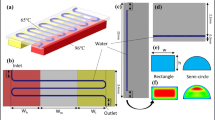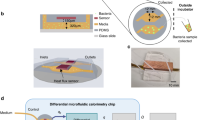Abstract
Evaporation is of great importance when dealing with microfluidic devices with open air/liquid interfaces due to the large surface-to-volume ratio. For devices utilizing a thermal reaction (TR) reservoir to perform a series of biological and chemical reactions, excessive heat-induced microfluidic evaporation can quickly lead to reaction reservoir dry out and failure of the overall device. In this study, we present a simple, novel method to decrease heat-induced fluid evaporation within microfluidic systems, which is termed as heat-mediated diffusion-limited (HMDL) method. This method does not need complicated thermal isolation to reduce the interfacial temperature, or external pure water to be added continuously to the TR chamber to compensate for evaporation loss. The principle of the HMDL method is to make use of the evaporated reaction content to increase the vapor concentration in the diffusion channel. The experimental results have shown that the relative evaporation loss (V loss/V ini) based on the HMDL method is not only dependent on the HMDL and TR region’s temperatures (T HMDL and T TR), but also on the HMDL and TR’s channel geometries. Using the U-shaped uniform channel with a diameter of 200 μm, the V loss/V ini within 60 min is low to 5% (T HMDL = 105°C, T TR = 95°C). The HMDL method can be used to design open microfluidic systems for nucleic acid amplification and analysis such as isothermal amplification and PCR thermocycling amplification, and a PCR process has been demonstrated by amplifying a 135-bp fragment from Listeria monocytogenes genomic DNA.










Similar content being viewed by others
References
Berthier E, Warrick J, Yu H, Beebe DJ (2008a) Managing evaporation for more robust microscale assays—Part 1. Volume loss in high throughput assays. Lab Chip 8:852–859
Berthier E, Warrick J, Yu H, Beebe DJ (2008b) Managing evaporation for more robust microscale assays—Part 2. Characterization of convection and diffusion for cell biology. Lab Chip 8:860–864
Blazej RG, Kumaresan P, Mathies RA (2006) Microfabricated bioprocessor for integrated nanoliter-scale Sanger DNA sequencing. Proc Natl Acad Sci USA 103:7240–7245
Bratten CDT, Cobbold PH, Cooper JM (1997) Micromachining sensors for electrochemical measurement in subnanoliter volumes. Anal Chem 69:253–258
Cheng JY, Hsieh CJ, Chuang YC, Hsieh JR (2005) Performing microchannel temperature cycling reactions using reciprocating reagent shuttling along a radial temperature gradient. Analyst 130:931–940
Cho YK, Kim J, Lee Y, Kim YA, Namkoong K, Lim H, Oh KW, Kim S, Han J, Park C, Pak YE, Ki CS, Choi JR, Myeong HK, Ko C (2006) Clinical evaluation of micro-scale chip-based PCR system for rapid detection of hepatitis B virus. Biosens Bioelectron 21:2161–2169
Dimov IK, Garcia-Cordero JL, O’Grady J, Poulsen CR, Viguier C, Kent L, Daly P, Lincoln B, Maher M, O’Kennedy R, Smith TJ, Ricco AJ, Lee LP (2008) Integrated microfluidic tmRNA purification and real-time NASBA device for molecular diagnostics. Lab Chip 8:2071–2078
Easley CJ, Karlinsey JM, Bienvenue JM, Legendre LA, Roper MG, Feldman SH, Hughes MA, Hewlett EL, Merkel TJ, Ferrance JP, Landers JP (2006) A fully integrated microfluidic genetic analysis system with sample-in–answer-out capability. Proc Natl Acad Sci USA 103:19272–19277
Effenhauser CS, Harttig H, Krämer P (2002) An evaporation-based disposable micropump concept for continuous monitoring applications. Biomed Microdevices 4:27–32
Eijkel JCT, van den Berg A (2005) Water in micro- and nanofluidics systems described using the water potential. Lab Chip 5:1202–1209
Ericsson O, Jarvius J, Schallmeiner E, Howell M, Nong RY, Reuter H, Hahn M, Stenberg J, Nilsson M, Landegren U (2008) A dual-tag microarray platform for high-performance nucleic acid and protein analyses. Nucleic Acids Res 36:e45
Goedecke N, Eijkel J, Manz A (2002) Evaporation driven pumping for chromatography application. Lab Chip 2:219–223
Gulliksen A, Solli L, Karlsen F, Rogne H, Hovig E, Nordstrøm T, Sirevåg R (2004) Real-time nucleic acid sequence-based amplification in nanoliter volumes. Anal Chem 76:9–14
Guttenberg Z, Müller H, Habermüller H, Geisbauer A, Pipper J, Felbel J, Kielpinski M, Scriba J, Wixforth A (2005) Planar chip device for PCR and hybridization with surface acoustic wave pump. Lab Chip 5:308–317
Hashimoto M, Barany F, Soper SA (2006) Polymerase chain reaction/ligase detection reaction/hybridization assays using flow-through microfluidic devices for the detection of low-abundant DNA point mutations. Biosens Bioelectron 21:1915–1923
Heuck F, Hug T, Akiyama T, Frederix PLTM, Engel A, Meister A, Heinzelmann H, de Rooij NF, Staufer U (2008) Evaporation based micro pump integrated into a scanning force microscope probe. Microelectron Eng 85:1302–1305
Hutchison CA 3rd, Smith HO, Pfannkoch C, Venter JC (2005) Cell-free cloning using Φ29 DNA polymerase. Proc Natl Acad Sci USA 102:17332–17336
Kopp MU, de Mello AJ, Manz A (1998) Chemical amplification: continuous-flow PCR on a chip. Science 280:1046–1048
Lam L, Sakakihara S, Ishizuka K, Takeuchi S, Arata HF, Fujita H, Noji H (2008) Loop-mediated isothermal amplification of a single DNA molecule in polyacrylamide gel-based microchamber. Biomed Microdevices 10:539–546
Legendre LA, Bienvenue JM, Roper MG, Ferrance JP, Landers JP (2006) A simple, valveless microfluidic sample preparation device for extraction and amplification of DNA from nanoliter-volume samples. Anal Chem 78:1444–1451
Litborn E, Roeraade J (2000) Liquid lid for biochemical reactions in chip-based nanovials. J Chromatogr B 745:137–147
Litborn E, Emmer A, Roeraade J (1999) Chip-based nanovials for tryptic digest and capillary electrophoresis. Anal Chim Acta 401:11–19
Litborn E, Emmer A, Roeraade J (2000) Parallel reactions in open chip-based nanovials with continuous compensation for solvent evaporation. Electrophoresis 21:91–99
Lynn NS, Henry CS, Dandy DS (2009) Evaporation from microreservoirs. Lab Chip 9:1780–1788
Marcy Y, Ishoey T, Lasken RS, Stockwell TB, Walenz BP, Halpern AL, Beeson KY, Goldberg SMD, Quake SR (2007) Nanoliter reactors improve multiple displacement amplification of genomes from single cells. PLoS Genet 3:e155
Matsubara Y, Kerman K, Kobayashi M, Yamanura S, Morita Y, Tamiya E (2005) Microchamber array based DNA quantification and specific sequence detection from a single copy via PCR in nanoliter volumes. Biosens Bioelectron 20:1482–1490
Michikawa Y, Sugahara K, Suga T, Ohtsuka Y, Ishikawa K, Ishikawa A, Shiomi N, Shiomi T, Iwakawa M, Imai T (2008) In-gel multiple displacement amplification of long DNA fragments diluted to the single molecule level. Anal Biochem 383:151–158
Minarik M, Klepárnik K, Gilár M, Foret F, Miller AW, Sosic Z, Karger BL (2002) Design of a fraction collector for capillary array electrophoresis. Electrophoresis 23:35–42
Moerman R, Knoll J, Apetrei C, van den Doel LR, van Dedem GW (2005) Quantitative analysis in nanoliter wells by prefilling of wells using electrospray deposition followed by sample introduction with a coverslip method. Anal Chem 77:225–231
Morisset D, Dobnik D, Hamels S, Zel J, Gruden K (2008) NAIMA: target amplification strategy allowing quantitative on-chip detection of GMOs. Nucleic Acids Res 36:e118
Namasivayam V, Larson RG, Burke DT, Burns MA (2003) Transpiration-based micropump for delivering continuous ultra-low flow rates. J Micromech Microeng 13:261–271
Neugebauer S, Evans SR, Aguilar ZP, Mosbach M, Fritsch I, Schuhmann W (2004) Analysis in ultrasmall volumes: microdispensing of picoliter droplets and analysis without protection from evaporation. Anal Chem 76:458–463
Neuzil P, Zhang CY, Pipper J, Oh S, Zhuo L (2006) Ultra fast miniaturized real-time PCR: 40 cycles in less than six minutes. Nucleic Acids Res 34:e77
Oh KW, Park C, Namkoong K, Kim J, Ock KS, Kim S, Kim YA, Cho YK, Ko C (2005) World-to-chip microfluidic interface with built-in valves for multichamber chip-based PCR assays. Lab Chip 5:845–850
Pal R, Yang M, Lin R, Johnson BN, Srivastava N, Razzacki SZ, Chomistek KJ, Heldsinger DC, Haque RM, Ugaz VM, Thwar PK, Chen Z, Alfano K, Yim MB, Krishnan M, Fuller AO, Larson RG, Burke DT, Burns MA (2005) An integrated microfluidic device for influenza and other genetic analyses. Lab Chip 5:1024–1032
Pilarski PM, Adamia S, Backhouse CJ (2005) An adaptable microvalving system for on-chip polymerase chain reactions. J Immunol Methods 305:48–58
Prakash AR, Adamia S, Sieben V, Pilarski P, Pilarski LM, Backhouse CJ (2006) Small volume PCR in PDMS biochips with integrated fluid control and vapour barrier. Sens Actuators B 113:398–409
Saiki RK, Scharf F, Faloona F, Mullis KB, Horn GT, Erlich HA, Arnheim N (1985) Enzymatic amplification of beta-globin genomic sequences and restriction site analysis for diagnosis of sickle cell anemia. Science 230:1350–1354
Sista R, Hua Z, Thwar P, Sudarsan A, Srinivasan V, Eckhardt A, Pollack M, Pamula V (2008) Development of a digital microfluidic platform for point of care testing. Lab Chip 8:2091–2104
Squires TM, Quake SR (2005) Microfluidics: fluid physics at the nanoliter scale. Rev Mod Phys 77:977–1026
Timmer BH, van Delft KM, Olthuis W, Bergveld P, van den Berg A (2003) Micro-evaporation electrolyte concentrator. Sens Actuators B 91:342–346
Toriello NM, Liu CN, Mathies RA (2006) Multichannel reverse transcription-polymerase chain reaction microdevice for rapid gene expression and biomarker analysis. Anal Chem 78:7997–8003
Toriello NM, Douglas ES, Thaitrong N, Hsiao SC, Francis MB, Bertozzi CR, Mathies RA (2008) Integrated microfluidic bioprocessor for single-cell gene expression analysis. Proc Natl Acad Sci USA 105:20173–20178
VanDijken J, Kaigala GV, Lauzon J, Atrazhev A, Adamia S, Taylor BJ, Reiman T, Belch AR, Backhouse CJ, Pilarski LM (2007) Microfluidic chips for detecting the t(4;14) translocation and monitoring disease during treatment using reverse transcriptase-polymerase chain reaction analysis of IgH-MMSET hybrid transcripts. J Mol Diagn 9:358–367
Walker GM, Beebe DJ (2002) An evaporation-based microfluidic sample concentration method. Lab Chip 2:57–61
Wang F, Yang M, Burns MA (2008) Microfabricated valveless devices for thermal bioreactions based on diffusion-limited evaporation. Lab Chip 8:88–97
Xu ZR, Zhong CH, Guan YX, Chen XW, Wang JH, Fang ZL (2008) A microfluidic flow injection system for DNA assay with fluids driven by an on-chip integrated pump based on capillary and evaporation effects. Lab Chip 8:1658–1663
Zhang CS, Xing D (2007) Miniaturized PCR chips for nucleic acid amplification and analysis: latest advances and future trends. Nucleic Acids Res 35(13):4223–4237
Zhang CS, Xing D (2009) Parallel DNA amplification by convective polymerase chain reaction with various annealing temperatures on a thermal gradient device. Anal Biochem 387:102–112
Zhang CS, Xu JL, Ma WL, Zheng WL (2006) PCR microfluidic devices for DNA amplification. Biotechnol Adv 24:243–284
Zhang CS, Xing D, Li YY (2007) Micropumps, microvalves, and micromixers within PCR microfluidic chips: advances and trends. Biotechnol Adv 25:483–514
Zimmermann M, Bentley S, Schmid H, Hunziker P, Delamarche E (2005) Continuous flow in open microfluidics using controlled evaporation. Lab Chip 5:1355–1359
Acknowledgments
This research is supported by the National Natural Science Foundation of China (30700155), the Key Program of NSFC-Guangdong Joint Funds of China (U0931005), the Program for Changjiang Scholars and Innovative Research Team in University (IRT0829) and the National High Technology Research and Development Program of China (863 Program) (2007AA10Z204).
Author information
Authors and Affiliations
Corresponding author
Rights and permissions
About this article
Cite this article
Zhang, C., Xing, D. Decreasing microfluidic evaporation loss using the HMDL method: open systems for nucleic acid amplification and analysis. Microfluid Nanofluid 9, 17–30 (2010). https://doi.org/10.1007/s10404-009-0508-4
Received:
Accepted:
Published:
Issue Date:
DOI: https://doi.org/10.1007/s10404-009-0508-4




